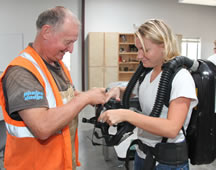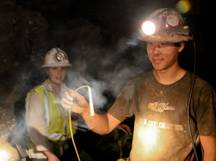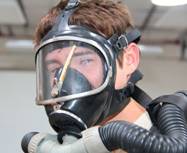UA gets $1.6 million for Mine Safety Center
A consortium of three UA colleges has received a three-year grant of $1.6 million to set up the Western Mining Safety and Health Training Resource Center.
The grant was awarded by the National Institute for Occupational Safety and Health (NIOSH), which is part of the Centers for Disease Control and Prevention.
The lead researchers on the project are ProfessorMary Poulton, head of the UA department of mining and geological engineering and director of the Lowell Institute for Mineral Resources; Professor Dr. Jeff Burgess, director of the community, environment and policy division at the UA Mel and Enid Zuckerman College of Public Health; and Professor Patty Anders of the department of teaching, learning and sociocultural studies at the College of Education.
The resource center will be directed by Ros Hill, a professor of practice in the department of mining and geological engineering and director of the San Xavier Underground Mining Laboratory. The center will cover the U.S. west of the Mississippi.
 |
| Training center director Ros Hill, left, helps mining engineering junior Allison Hagerman get into a mine rescue breathing apparatus in the training center at the San Xavier mining lab. The Drager BG-4 mine rescue rebreathers were a gift to the mine from Barrick, a global gold mining company. |
The training center will address those mining safety and health training issues which could be considered unique to the West, Hill said. Our focus is more on metal mining and sand, gravel and stone, as opposed to the coal focus in the East.
An objective of the center will be the development of new methods and materials to make mine safety training more effective. The center will share these methods and materials with other mine safety trainers, and collect evaluations from all western states training classes. The grant will also be used to enhance the mine rescue and recovery capacity at the San Xavier Mining Laboratory.
The feedback from trainers throughout the western states will be used to evaluate how well the new methods and materials are working, and ongoing support for miners will be provided via the Internet. Overall, the result will be more miners trained in mine rescue and mine safety and health.
Poulton said that in addition to the UA colleges, the center will involve collaboration with some of the largest mining companies in the Western U.S., and with the Arizona State Mine Inspector's Office, trainers in other western states, and private training firms.
 |
| Mining engineering student Danny Marsh holds a lit fuse in the San Xavier mine. It's hooked up to dozens of explosive charges, so he has to make sure it's burning properly before leaving the mine. It's a slow-burning fuse, so he has about 5 minutes to make checks and get to safety. |
Our goal is for the UA to be a center of excellence in mine health and safety and this grant continues to grow our national prominence, said Poulton. We have a unique facility at our San Xavier Mine and recent infrastructure improvements at the mine, funded by Science Foundation Arizona and Freeport McMoRan Copper & Gold, have allowed us to expand the scope of our research and training.
Through these partnerships we will be able to improve the health and safety training of thousands of miners with new language training modules, gaming simulations for avoiding mine accidents, translational research and training for occupational health and environmental exposure assessments, and mine rescue practice, Poulton said.
The Mel and Enid Zuckerman College of Public Health has been working with the department of mining and geological engineering for almost ten years, including joint development of mining health and safety training programs in southern Africa.
It is important to provide effective materials for use in workplace training, Burgess said. We look forward to helping reduce injuries and exposures in miners through this collaborative project. In addition to Burgess, four other public health faculty and staff will participate in the new training program.
The involvement of the department of teaching, learning and sociocultural studies reflects the importance of education to the center's mission. Another important goal for the center will be the creation and delivery of a curriculum in a manner that encourages mine safety and community health for mine workers from all backgrounds.
 |
| Mining engineering sophomore Luke Sturgeon dons a rebreather mask. The breathing apparatus, one of six donated to the mine by Barrick, costs almost $10,000 and is essential to mine rescue operations. |
"Safety in and around mines relies on clear verbal and printed communication," said Patty Anders, who is the Jewell M. Lewis distinguished professor of reading in the department of teaching, learning and sociocultural studies. "Helping supervisors and miners speak, write, and read clearly is essential to safety."
Anders pointed out that mine workers have huge differences in their literacy and language use and understanding. "We will design new and redesign existing training programs to increase the probability that all miners will understand and be able to use information to be safe," she said.
The grant application was supported in part by the Arizona State Mine Inspector's Office. "Supporting and cooperating with the University of Arizona highlights the vision of the Arizona State Mine Inspector's office and our commitment to the education and training of Arizona miners," said Joe Hart, Arizona State Mine Inspector. "The development of this program will provide continuous improvement of mine safety by providing state-of-the-art training delivery methods to the Arizona mining industry."
Story and photos by Pete Brown

